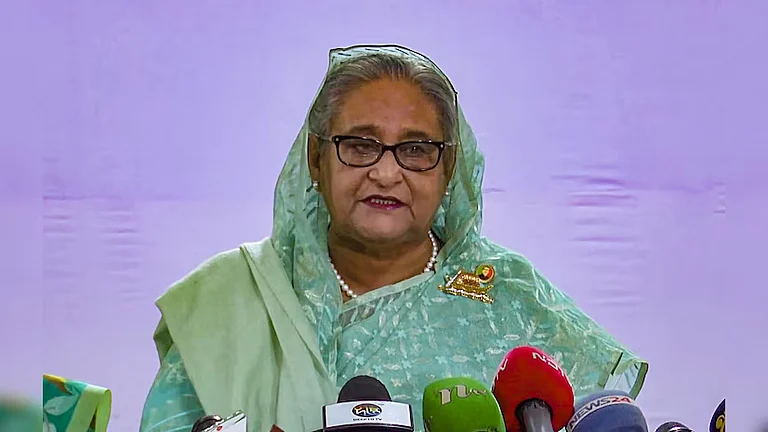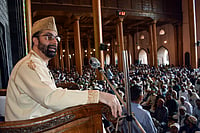Has the Internet become an avatar of Gandhi’s charkha? Can its many marvels—social media, participative democracy, collaborative science, et al—have the transformative energy of the spinning wheel? Excerpts from a new book, to be released by former president A.P.J. Abdul Kalam on September 4 at Gandhi Smriti in New Delhi
The history of human evolution is, in some defining ways, the history of man-machine relationship. It is captured, partly though not fully, by the evolution of the tools—technologies in the current idiom—that man has invented to satisfy his material, socio-political, knowledge-seeking, cultural, artistic and spiritual needs. With the advent of the Industrial Revolution in Europe in the 18th century came a time when the man-machine relationship underwent a dramatic transformation, at once liberative and lethal. Breathtaking advances began to be made in science, creating products that quickened and broadened social change. However, they also violently altered the political map of the world. This is because machines, including war machines, became tools in the hands of colonisers, exploiters, plunderers and empire-builders. Traditional societies in Asia, Africa and America, which had created diverse and priceless intellectual, cultural and wisdom traditions of their own, were robbed of their freedom, resources and livelihoods. Worse, the colonisers claimed that they had a divine mandate to modernise and civilise the enslaved peoples.
Enter Mahatma Gandhi. The leader of a national liberation struggle the like of whom history has never produced. There are many unique aspects of the man, his message and the method he evolved to challenge the mightiest empire of his time, and these have been illuminatingly explored in thousands of books. His lifelong and uncompromising commitment to truth (satya) and non-violence (ahimsa), and his heroic campaign for inter-faith harmony culminating in his martyrdom, have inspired the entire world. Thinking people everywhere acknowledge his greatness and believe his message to be relevant both today and tomorrow.
However, inadequate and unsatisfactory attention has so far been paid to how Gandhi sought to fundamentally challenge the man-machine paradigm of imperialism. This is because of the deeply entrenched view, held even by his admirers, that he was opposed to science, technology, machinery and modernity. This has persuaded many people in India and the world to believe that Gandhi, with his insistence on khadi, charkha and maximum local self-sufficiency (swadeshi), sought to stop the onrush of development aided by modern science and technology. Therefore, on the yardstick of technology-driven progress, many of Gandhi’s admirers and critics alike consider him irrelevant to our times.
We confront a strange paradox here. Khadi and the spinning wheel have become largely irrelevant today, even though the message they iconified has become more relevant than ever. This being so, does Gandhi’s timeless message have a new technological carrier that can become the spinning wheel’s reincarnation in the 21st century?
Yes. It is the Internet.
The more I dug into the above-mentioned paradox, the more convinced I became that Gandhi was far from being an opponent of modern science and technology. His writings and activities provide enough evidence to dynamite the mountain of misconception on this score. Indeed, by redefining modernity and development, the Gandhian vision seeks to relocate the place of science and its practical uses in the overall terrain of human affairs where it can promote mankind’s holistic progress, and not be used for exploitation and violence. The Mahatma elevates science to a higher level of human pursuit and imparts to it a nobler purpose that is consistent with both mankind’s needs and the Divine Law.
***
Gandhi was a genius in symbolising his socio-political and spiritual message. No Gandhian icon has endured more as a synonym for his personality and philosophy than his humble spinning wheel. He worked magic with this simple machine by imparting a mass and moral character to India’s struggle for freedom. He also used it as a powerful symbol for his advocacy of a new global order, based on the ideals of truth, non-violence, justice, universal brotherhood, respect for nature and ethically guided socio-economic development. However, he was by no means dogmatic about the charkha remaining the sole instrument of his economic philosophy forever and everywhere. He repeatedly urged both his followers and his critics to understand what khadi and the charkha stood for, what they connoted. Khadi, he insisted, was not merely a vastra (cloth) but a vichaar (an idea and an ideal). And he was realistic enough to know, and also to explicitly acknowledge, that new historical circumstances would need new tools and technologies to promote his vichaar. Indeed, towards the end of his life, he had contemplated a ‘better substitute’ for the charkha and even anticipated the birth of a new technological device, a non-violent machine that “helps every individual” everywhere in the world.
The Internet fulfils the expectations of the ideal machine that Gandhi had been visualising. Obviously, he could not have pictured in his mind the birth of the digital era. Nevertheless, it is one of the little-recognised facets of Gandhi’s greatness that he was anticipating, and hoping for, the arrival of a new scientific tool that would promote his vision of a just and holistic development of the entire human race.
***
The Mahatma’s choice of the spinning wheel as a symbol to proclaim his vision was deliberate: he opted for the simplest and the least technologically developed tool to symbolise his mission only to underscore the fact that the western economic system had misused modern science and technology for colonial exploitation and for promoting a soul-less materialistic ‘civilisation’, both of which necessitated wars and violence on a massive scale. However, Gandhi had a strong historical sense to affirm that the European domination of the world was a “nine-day wonder”, and that the future would summon a just, new global order if backed by a sufficiently powerful, determined, wisdom-directed human effort—what he called a ‘New Thought Revolution’. He was acutely aware that new tools of science and technology would be needed, and would be born, in the future to realise what the spinning wheel stood for in his time. For example, this is what he wrote in his journal Young India on February 5, 1925:
Many things are impossible and yet are the only things right. A reformer’s business is to make the impossible possible by giving an ocular demonstration of the possibility in his own conduct. Whoever thought it possible before Edison to speak to people hundreds of miles away from us? Marconi went a step further and made wireless communication possible. We are daily witnessing the phenomenon of the impossible of yesterday becoming the possible of today. As in physical science so in psychological. (Emphasis added.)
Tom Standage, in his fascinating book The Victorian Internet, describes Marconi’s telegraph as a precursor to today’s Internet. Gandhi was an enthusiastic user of the ‘Victorian Internet’. If he embraced what was state-of-the-art communication technology in his time, why wouldn’t he have done the same now? Indeed, how could Gandhi, who had profound respect for—indeed, a romantic relationship with—science, have shunned what is indubitably the greatest scientific invention in human history?
***
Describing the Internet as an avatar of the charkha will surely raise eyebrows. However, for proof, just look at how digital technologies are dramatically transforming our world. The political conditions that gave rise to the use of science and technology in the pre-Internet era for the exploitation, domination and disempowerment of large masses of people are speedily changing. A new networked global community is emerging in which digital technologies are providing intellectual and practical tools to the common people to challenge iniquitous social, political and economic structures. Indeed, mankind has so far seen only the proverbial tip of the iceberg as far as the transformative power of the digital-age technologies is concerned. The 21st century will bring a tsunami of changes that will transform the material aspects of our world beyond recognition at all levels—global, national and local. For example, Ray Kurzweil, a celebrated techno-futurist whom I interviewed, writes in his landmark book The Singularity is Near: When Humans Transcend Biology (2005): “I set the date for the Singularity—representing a profound and disruptive transformation in human capability—as 2045. The non-biological intelligence created in that year will be one billion times more powerful than all human intelligence today.” (Kurzweil also said to me in the interview: “Gandhi is a prophet for the age of the communication revolution.”)

Universal connectivity; emergence of new communities in the virtual space transcending the barriers of race, religion and nationality; social media on which new friendships blossom each day; participative democracy at international, national and local levels; steady progress towards inclusive development both globally and within nations giving rise to the real possibility of poverty becoming history throughout the world; trans-border collaborative scientific research; new tools to preserve and promote the heritage of arts, culture and indigenous knowledge traditions; the promise of new technologies to arrest and reverse the humungous damage wrought on the environment— all these changes prove how the Internet is promoting the ‘khadi spirit’. For they will mean transition from globalisation to glocalisation; from centralisation to decentralisation; from power and prosperity in the hands of a few to many; from prosperity defined purely in material terms to that which gives primacy to the richness of culture and ethical values; from unhealthy competition to healthy cooperation; from an exploitative attitude towards nature and its resources to an attitude of harmonious co-living. The disconnect between economics and ethics, which the world has experienced for the past several centuries with the onset of colonialism and the mad race to conquer distant markets, will be substantially reduced. Old technologies gave birth to this exploitative order. New technologies, if used wisely, will dig its grave. Several forms of large-scale violence, such as wars between nation-states, will become a thing of the past. Isn’t this what khadi and the spinning wheel of Gandhi’s conception stood for?
This discovery and its comprehensive exposition, I modestly claim, are my book’s distinctive contribution to the study of Mahatma Gandhi. Among other things, I have attempted to show how Gandhian ideals have been echoed by many pioneering thinkers and innovators in the world of digital technologies—Norbert Wiener, Alan Turing, Vannevar Bush, J.C.R. Licklider, Jon Postel, Doug Engelbart, Tim Berners-Lee, Richard Stallman, K. Eric Drexler, Lawrence Lessig, Bill Joy, Jaron Lanier, Michio Kaku, and others. Another legendary and universally admired name from the digital world—Apple co-founder Steve Jobs—must also be included in this list. His famous biographer Walter Isaacson tells us how Gandhi was one of Jobs’s personal heroes who inspired him to ‘Think Different’.
A good deal of the new research over the future of the Internet, which can best be described as the “species mind of humankind”, substantiates the main argument in my book. For example, In World Wide Mind—The Coming Integration of Humanity, Machines and the Internet, author Michael Chorost posits that the coming together of the human mind and the machine mind can make all of us more human and not less.
Gandhi had audaciously prophesied that science itself would, in future, advance the cause of non-violence. “We are constantly being astonished at the amazing discoveries in the field of violence. But I maintain that far more undreamt of and seemingly impossible discoveries will be made in the field of non-violence.” His prophecy will be fulfilled by the Internet, provided it is guided by satyagraha (truth force) and swaraj (the ethic of enlightened self-governance at all levels, from the individual to the global).
***
That Gandhi was deeply religious in his outlook and practice is well known. But what is little known is that he was also extremely scientific in all matters where science has a place. “My life is largely governed by reason and when it fails, it is governed by a superior force that is faith,” he said. “The wholest of men, and one of the most miraculously energetic” is how Erik Erikson has described him in his Pulitzer Prize-winning book Gandhi’s Truth: On the Origins of Militant Non-violence. I have humbly set out to portray the “wholeness” of Gandhi’s life, his integral, non-compartmentalised, scientific and ethics-inspired worldview. I have also sought to introduce the readers, especially young readers who are curious but insufficiently familiar with his life and philosophy, to many hard-to-believe facets of his personality—how the Mahatma was also an educationist, spinner, scavenger, cobbler, cook, nurse, nature cure specialist, dietician, beekeeper, carpenter, an avid user of the microscope and the telescope, a champion of technological innovation and an experimentalist par excellence.

An inseparable part of Gandhi’s Truth is his ill-understood approach to human sexuality, which is now being so profoundly influenced by the Internet. My exploration of his brahmacharya practice (sexual self-restraint being a partial meaning of it) forms the longest chapter in the book. His life and philosophy cannot be understood without studying the interconnectedness between truth, non-violence and brahmacharya, which was highly scientific and goal-oriented, and not the outcome of some irrational and prejudiced understanding of a man-woman relationship. He believed that a perfect brahmachari acquires superhuman powers, which he or she can harness for achieving a positive social goal. The very fact that someone in our epoch endeavoured to divinise his sexual energy to promote non-violence on a societal scale carries immense insights and promises for the future evolution of human sexuality. Therefore, our world, which is intoxicated with superficial images, understandings and practices of sex, has as much to learn from Gandhi in this department of life as in others such as economy, ecology, disarmament, women’s empowerment, inter-faith harmony and social justice.
***
One last point: This book is not the work of idle academic curiosity about an iconic figure of yesteryear. It is a call to action and service, based on my reflections on what Gandhi means to India and the world, today and tomorrow. Our country, in particular, needs to rediscover the relevance of his teachings if it is not to commit the follies of its own past and, also, if it is not to repeat the follies of the West. In his teachings, we find the right guidance to reunite our divided society and also our fractured subcontinent. In his teachings, we find the right principles to reform our economic and political systems, both of which are today mired in deepening corruption. In his teachings, we find that a new and harmonious man-nature relationship, which is now badly ruptured to the detriment of both, can indeed be created with the right use of modern technologies. Finally, his teachings are also a call, as described in this book, for human beings, who are today “less than human”, to become “more than human” by ascending the Godward evolutionary path.
I have summed up my appeal for action in the epilogue by saying, “It’s time we all became Internet Satyagrahis”. A new age is dawning. This is not the hour to be caught asleep.


























